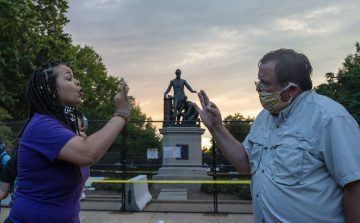
Kenan Malik in the NYRB:
“We stand today at the national center to perform something like a national act—an act which is to go into history.”
So said the great nineteenth-century former slave and staunch abolitionist Frederick Douglass at the unveiling of the Emancipation Memorial in Lincoln Park, Washington, D.C., in 1876. “That we are here in peace today,” Douglass told a crowd of almost 25,000, many of them African-American, “is a compliment and a credit to American civilization, and a prophecy of still greater national enlightenment and progress in the future.”
The idea for the memorial had come originally from former slave Charlotte Scott, of Virginia, who wanted a monument in honor of Abraham Lincoln. She gave five dollars to begin a funding drive, and the monument was eventually paid for entirely by former slaves.
Almost a hundred and fifty years later, many African Americans feel differently about the memorial. In June, Black Lives Matter protesters attempted, unsuccessfully, to topple the statue. D.C. Congresswoman Eleanor Holmes Norton vowed to introduce legislation to have the memorial removed. The Boston Art Commission unanimously resolved to take down a copy of the statue in Boston.
Some critics of the statue view Lincoln as a false friend of African Americans. Others see the statue itself as demeaning, with Lincoln represented as standing upright, while the free black man is on his knees. For defenders of the statue, on the other hand, to remove it is to erase a memorial paid for by former slaves and anointed by Douglass. It is to besmirch black history itself.
What is striking in this contemporary debate is that there is nothing new about it.
More here.
